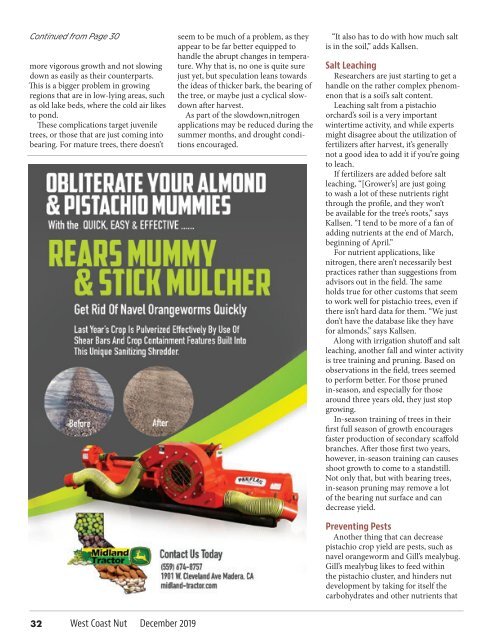WCN December 2019
You also want an ePaper? Increase the reach of your titles
YUMPU automatically turns print PDFs into web optimized ePapers that Google loves.
Continued from Page 30<br />
more vigorous growth and not slowing<br />
down as easily as their counterparts.<br />
This is a bigger problem in growing<br />
regions that are in low-lying areas, such<br />
as old lake beds, where the cold air likes<br />
to pond.<br />
These complications target juvenile<br />
trees, or those that are just coming into<br />
bearing. For mature trees, there doesn’t<br />
seem to be much of a problem, as they<br />
appear to be far better equipped to<br />
handle the abrupt changes in temperature.<br />
Why that is, no one is quite sure<br />
just yet, but speculation leans towards<br />
the ideas of thicker bark, the bearing of<br />
the tree, or maybe just a cyclical slowdown<br />
after harvest.<br />
As part of the slowdown,nitrogen<br />
applications may be reduced during the<br />
summer months, and drought conditions<br />
encouraged.<br />
“It also has to do with how much salt<br />
is in the soil,” adds Kallsen.<br />
Salt Leaching<br />
Researchers are just starting to get a<br />
handle on the rather complex phenomenon<br />
that is a soil’s salt content.<br />
Leaching salt from a pistachio<br />
orchard’s soil is a very important<br />
wintertime activity, and while experts<br />
might disagree about the utilization of<br />
fertilizers after harvest, it’s generally<br />
not a good idea to add it if you’re going<br />
to leach.<br />
If fertilizers are added before salt<br />
leaching, “[Grower’s] are just going<br />
to wash a lot of these nutrients right<br />
through the profile, and they won’t<br />
be available for the tree’s roots,” says<br />
Kallsen. “I tend to be more of a fan of<br />
adding nutrients at the end of March,<br />
beginning of April.”<br />
For nutrient applications, like<br />
nitrogen, there aren’t necessarily best<br />
practices rather than suggestions from<br />
advisors out in the field. The same<br />
holds true for other customs that seem<br />
to work well for pistachio trees, even if<br />
there isn’t hard data for them. “We just<br />
don’t have the database like they have<br />
for almonds,” says Kallsen.<br />
Along with irrigation shutoff and salt<br />
leaching, another fall and winter activity<br />
is tree training and pruning. Based on<br />
observations in the field, trees seemed<br />
to perform better. For those pruned<br />
in-season, and especially for those<br />
around three years old, they just stop<br />
growing.<br />
In-season training of trees in their<br />
first full season of growth encourages<br />
faster production of secondary scaffold<br />
branches. After those first two years,<br />
however, in-season training can causes<br />
shoot growth to come to a standstill.<br />
Not only that, but with bearing trees,<br />
in-season pruning may remove a lot<br />
of the bearing nut surface and can<br />
decrease yield.<br />
Preventing Pests<br />
Another thing that can decrease<br />
pistachio crop yield are pests, such as<br />
navel orangeworm and Gill’s mealybug.<br />
Gill’s mealybug likes to feed within<br />
the pistachio cluster, and hinders nut<br />
development by taking for itself the<br />
carbohydrates and other nutrients that<br />
32<br />
West Coast Nut <strong>December</strong> <strong>2019</strong>


















